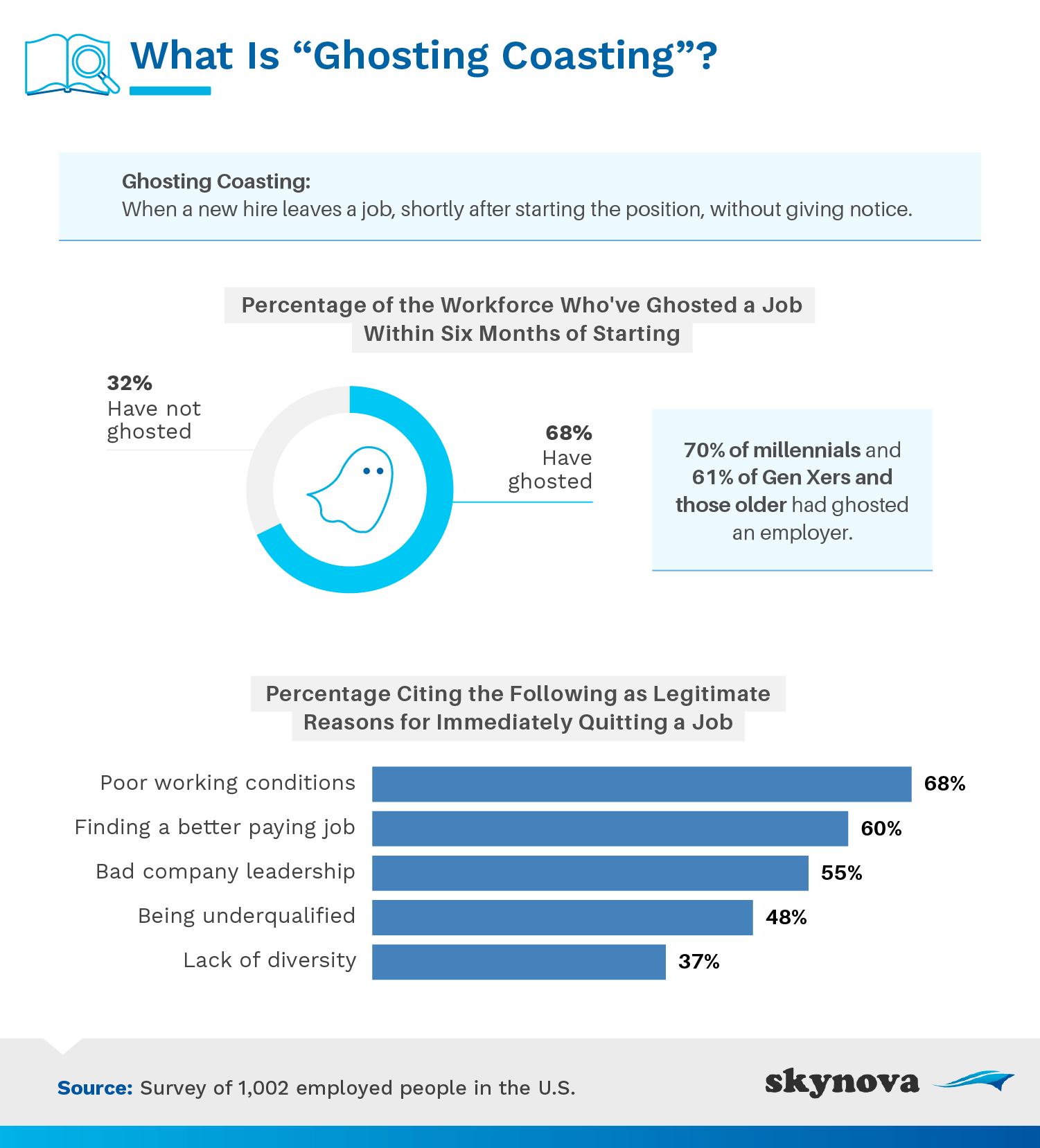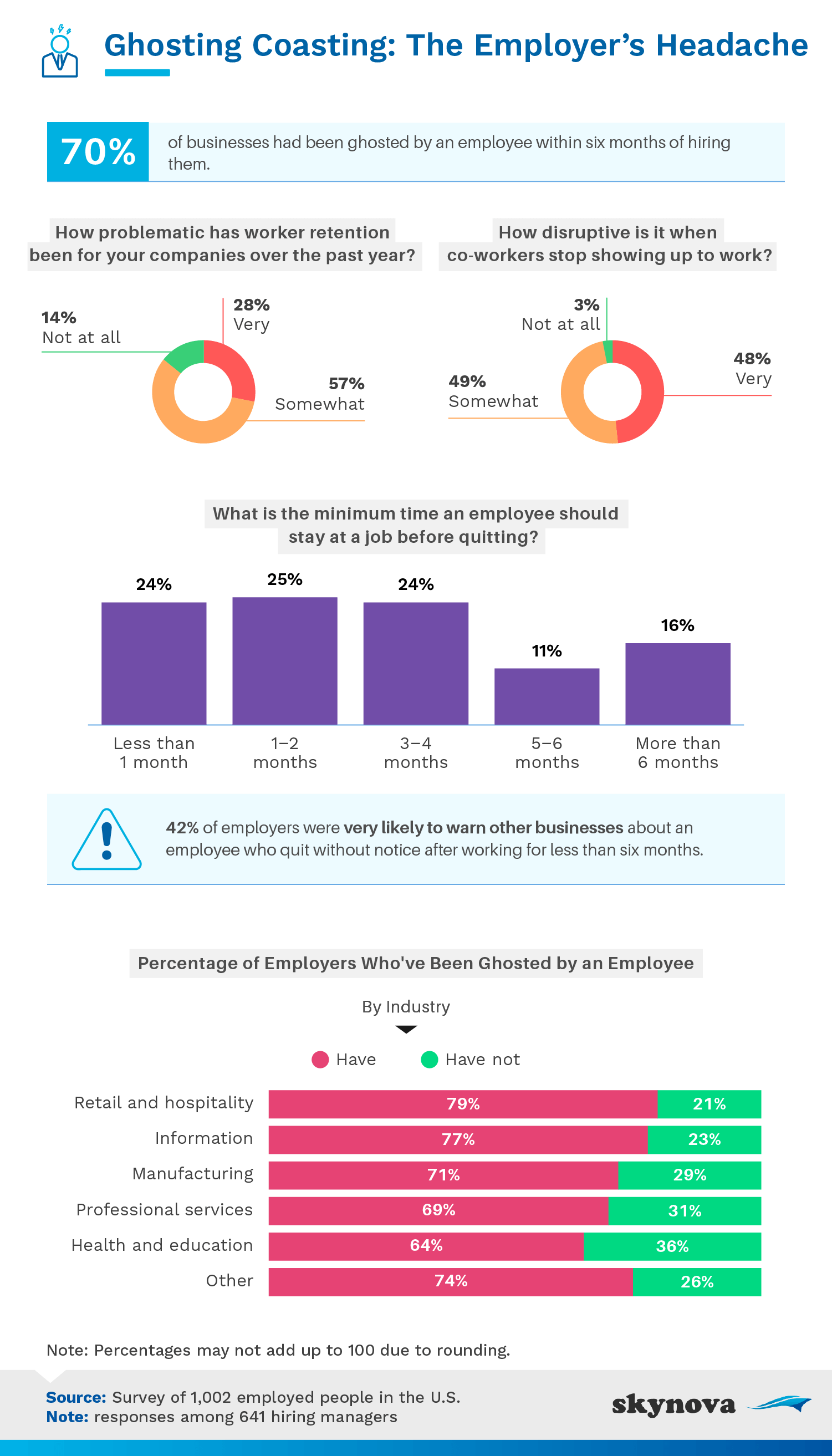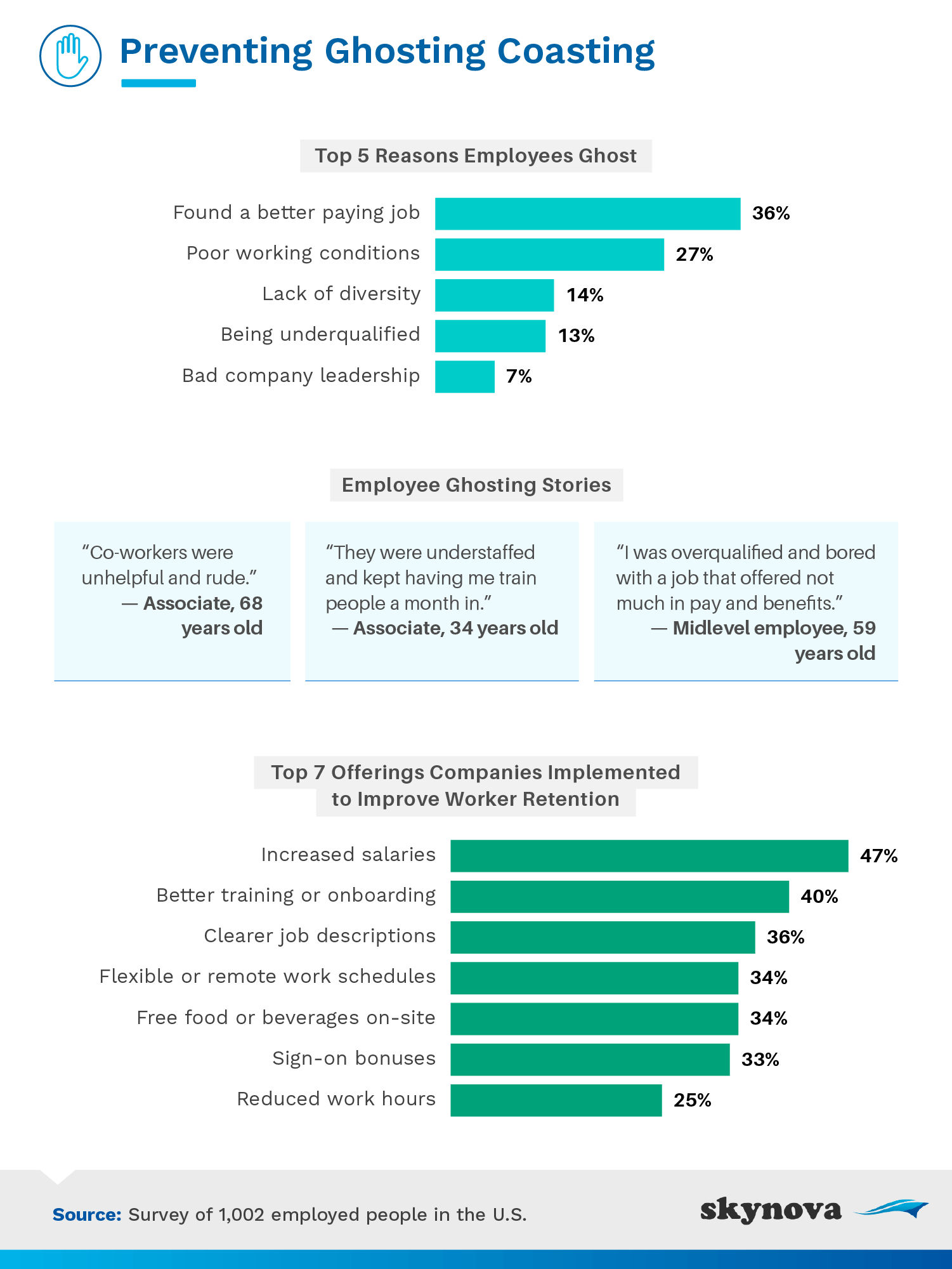
|
Ghosting coasting is something that has become more and more of an issue for employers in recent years, especially following the onset of the COVID-19 pandemic. Ghosting coasting happens when an employee leaves a company without giving notice and not long after being hired. This practice has become especially prevalent as a result of the recent labor shortage, which has led companies to widen their scope and hire a broader range of people with fewer conditions. It’s something that more and more employers seem to be dealing with, but what are the underlying employee issues that are causing it to happen?
To find out more, we surveyed 1,002 employees about the practice of ghosting coasting, asking why some people do it, how many have engaged in this practice themselves, and how employers can do better to improve retention.
Most people likely have their reasons for moving on from a job. Oftentimes, a better opportunity presents itself that necessitates an employee leaving their current position. Ghosting coasting is a more heightened version of this, as it happens with no warning at all and leaves employers scrambling to fill the suddenly vacant position. We asked respondents about their own experiences with ghosting coasting to get a sense of who’s done it and the reasons they think are valid for doing so.

Overall, 68% of employees surveyed had ghosted within six months of starting a job. Broken down by generation, 70% of millennials and 61% of Gen Xers and older respondents had quit a job within the first six months without giving notice or an explanation.
Notably, the reasons that respondents said are most justifiable for immediately leaving a job were poor working conditions (68%), finding a better paying job (60%), and bad company leadership (55%). Overall, younger generations were more likely to find all of these reasons appropriate than those aged 50 and over. Similarly, while only 23% of those aged 50 and over felt that quitting due to a lack of diversity was appropriate, 42% of those in their 20s found it perfectly acceptable.
Though employees ghost for many different reasons, it’s ultimately a major burden on an employer who has to quickly fill the gap or restructure responsibilities to make up for the shortage that comes as a result of an employee’s sudden departure. Respondents who identified as being part of the hiring process weighed in to shed some light on how ghosting coasting really impacts employers.

Overall, 70% of businesses had been ghosted by an employee within six months of them starting in a position. This obviously worsens the already serious problem of employee retention—something that 57% of respondents said had been somewhat of an issue for their business over the past year, and 28% of who admitted had been a major problem. Just 14% said it hadn’t been an issue whatsoever. Not surprisingly, 48% also agreed that a co-worker failing to show up to work was very disruptive to other employees.
Opinions varied on what was a respectable minimum amount of time for someone to stay at a job before leaving. However, the general consensus among respondents was that a range of anywhere from less than a month up to four months was most acceptable. Specifically, roughly a quarter of people voted for each of the following three categories: "Less than one month", "1-2 months", and "3-4 months". Given that expectations appear to be relatively low, it’s surprising that so many employees feel the need to leave without giving notice of their decision.
Retail and hospitality seem to be experiencing the biggest problem with ghosting coasting, with 79% of hiring managers for this industry saying they’ve been ghosted. The industry with the lowest percentage of employers saying the same was health and education (64%). However, all of the industries represented in our study appeared to have dealt with more than their fair share of this phenomenon.
Preventing ghosting coasting from occurring surely depends on the industry and all of the factors that could prompt someone to suddenly move on from a job, but there are things employees can do to improve retention and help avoid situations where employees feel forced to leave without notice.

Among respondents involved in the hiring process, 47% said increasing salaries was the top strategy they implemented for improving worker retention. Other things employers did to help the issue included better training or onboarding (40%), having clearer job descriptions (36%), and allowing for flexible or remote work schedules (34%).
The top reason employees ghosted, according to respondents, was finding a better paying job (36%)—something that increasing salaries would surely help to remedy. Other reasons included poor working conditions (27%), lack of diversity (14%), and being underqualified for the role (13%).
With seventy percent of millennials admitting to ghosting an employer, ghosting coasting is a major problem in the workplace. It has impacted all industries, with retail and hospitality taking the biggest hit. Businesses are taking measures to retain their employees, such as increasing wages and offering better training. With labor shortages continuing, employers will likely pay attention to issues like ghosting coasting and put measures in place to ensure that retention improves and that their employees feel compelled to stay in their job as long as possible.
Skynova provides online software including invoices, accounting, timesheets, and more for small businesses. In addition, we like to write in-depth articles about various topics we, and hopefully our customers, find interesting. They generally have a business or workplace angle, and often intersect with another area of society (e.g., business and technology, politics, sports, health). Articles are based on surveys, statistics, and our own research.
We used Amazon Mechanical Turk to collect the responses of 1,002 employed people in the United States. 676 respondents had quit a job within six months of starting work. 641 respondents were moderately to extremely likely to be involved in hiring decisions. 59.2% of our participants identified as men, 40.3% identified as women, and roughly 0.5% identified as nonbinary or nonconforming. Participants ranged in age from 19 to 89 years old with a mean of 38 and a standard deviation of 11. Those who reported no current employment or who failed an attention-check question were disqualified.
The data we are presenting rely on self-report. There are many issues with self-reported data. These issues include, but are not limited to, the following: selective memory, telescoping, attribution, and exaggeration.
Are you an employer struggling with retention who’s interested in our findings? Feel free to share! We just ask that you link back to this study and that your purposes are noncommercial in nature.